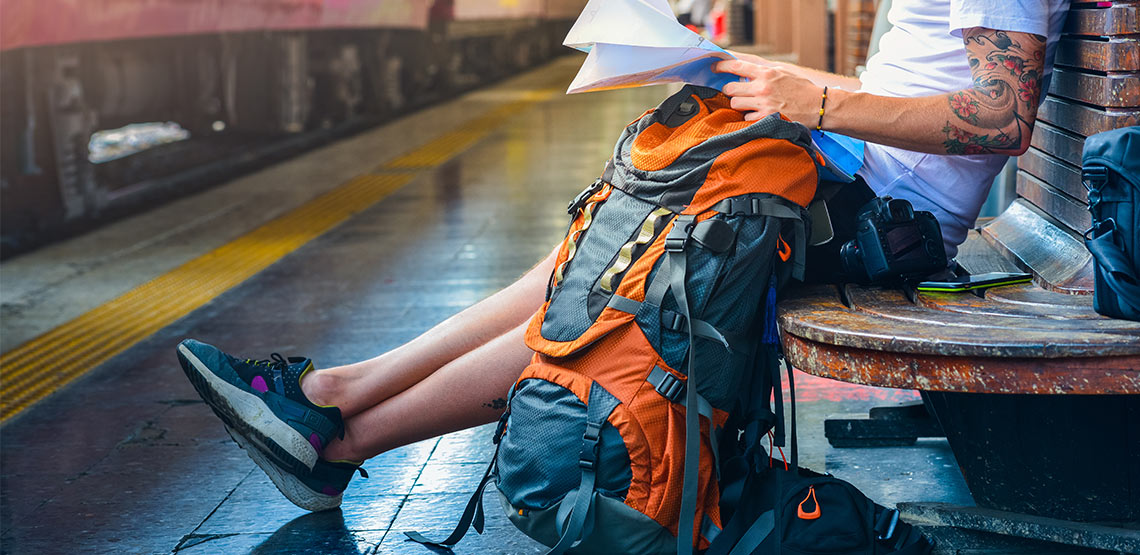Travel Light & Stay Organized with These Backpacking Packing Tips
It’s a Bit of an Art
If you’re heading out for a big travel adventure, packing your backpack correctly is important. Get it right, and you’ll be able to carry everything you need conveniently on your back. Get it wrong, and you’ll be lugging around an awkward bag of excess stuff that makes your back ache and your shoulders go numb.
In between walking through airport terminals and from the bus station to your hostel, you’re probably going to be covering a lot of ground with your backpack on. Make sure it’s light and well-packed enough that it won’t cause you serious pain.
As a general rule, I always make sure I can walk for a minimum of half an hour with my backpack on. If I can’t, that’s a sign that I need to reduce what I’m carrying (or improve my fitness).
But how do you strike a balance between having what you need and bringing too much stuff? This can be a difficult thing to figure out if you’ve never done any backpacking before. And while there is certainly room for trial and error as you learn what works best for you, it’s always nice to be able to use the experience of others to start off slightly ahead of the game.
So we’ll help you out and hopefully you won’t have too many adjustments to make while you’re on the road. Here are some tips for how to pack a backpack.
Take Less Stuff
The best tip I can give you for packing your backpack is to look at the amount of stuff you want to take traveling and cut it down by at least 20%. Trust me, once you hit the road you won’t need it.
The less stuff you have, the easier it will be to fit everything into your backpack and the less physical strain you will endure when carrying it around. You’d be surprised by all the things you don’t need. Now is the time to embrace that minimalist lifestyle everyone is talking about.
Use Packing Cubes
Packing cubes are brilliant. I only started using them a couple of years ago, but I wish I had embraced them sooner. You can roll up your clothes tightly in a packing cube, then place the cubes in your bag. You can also use a packing cube for the items you’ll need accessible right away, such as your toothbrush and pajamas.
When you arrive and you want to find that one particular shirt, you don’t have to pull all of your clothes out of your backpack looking for it. You can simply take out the appropriate packing cube and unzip that. It’s so much more convenient and prevents the dreaded “bagsplosion” that always happens when you get to the hostel room.
Packing cubes are also a great way to make sure your dirty and clean clothes stay separate. You’ll thank yourself for the extra care you took to stay organized every time you have to unpack and repack your backpack.
Distribute the Weight Properly
Logic might tell you that the heaviest items in your backpack should be right at the bottom. However, that’s not actually the best approach. Instead, clothes should be at the bottom and the heaviest items should be centered close to your back between your shoulder blades. That way, the weight is more balanced rather than digging into your hips and lower back.
This is what long distance hikers do when they have to carry a pack for dozens of miles across the countryside. You might not be walking as many as miles as they do with your pack on, but straining your back is a definite possibility even if you’re only going a short distance. The last thing you want to be dealing with on your trip is back pain.
Bulky Items First
Imagine that you have to fill a jar with rocks and sand. Logically, you would put the largest rocks in first, then pour the sand in so that it can fill in the crevices between the rocks. The same idea applies to the items in your backpack.
Place the largest items in first, such as your packing cubes full of clothes. Then, you can squeeze other small items into the gaps left between them. In time you’ll have a whole system for this and will know exactly what ordering works best for your bag and items.
Learn how not to overpack while still bringing everything you'll need for your cruise! Plus we include a cruise packing list, so you won't forget a thing.
Don’t Attach Extras
If you don’t have enough room in your backpack for everything, it can be tempting to attach it to the outside of the bag (for example, tying a pair of shoes on by the laces.) However, this is not a great strategy.
Not only will you be annoyed about the extra item slapping against you as you walk, you’ll throw off your balance and make your entire backpack more awkward to carry. Also, there’s the danger of your dangling extras getting caught on something as you walk — or trapped in the doors of a train.
If it doesn’t fit within your bag, don’t bring it.
Always be Adjusting
The contents of your backpack should be ever-changing, especially if you are traveling long-term. After a few weeks on the road, you’ll find that there are things you are carrying that you hardly ever use and you’ll decide to donate them to charity and lighten your load. You’ll also buy other items you need along the way.
Your backpack should contain a collection of items that you are always editing and making smart decisions about, rather than just carrying around for the sake of it.
This might be a difficult exercise for the sentimental types who like to hang onto everything in case they need it in the future. Likewise, backpacking is not the time to start a collection of shot glasses or fridge magnets from every place you’ve visited. Let this be one of the many lessons you’ll learn on the road about letting go of extra baggage to make room for new experiences.










